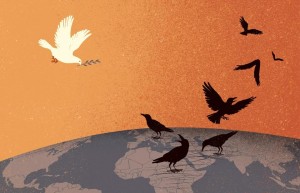By Joshua S. Goldstein and Steven Pinker, April 21, 2016, published in The Boston Globe

DAVID BONAZZI FOR THE BOSTON GLOBE
QUIETLY, AMID the carnage and chaos in the daily news, 2016 is shaping up as a good year for peace in the world. You read that right. A significant escalation of war over the past few years is, at the moment, abating.
For nearly two-thirds of a century, from 1945 to 2011, war had been in overall decline. The global death rate had fallen from 22 per 100,000 people to 0.3. But then the Syrian civil war became the bloodiest conflict in a generation, with hundreds of thousands killed, millions displaced, and multiple foreign powers joining the fight or supporting their proxies. The UN Security Council deadlocked on what to do about it, and eventually ISIS carved out a territory and enlarged it into Iraq and beyond.
New wars cropped up elsewhere. The world’s youngest country, South Sudan, fell into grotesque tribal violence. Nigeria lost territory to Boko Haram, with its penchant for kidnapping girls and other ways of brutalizing civilians. A Christian-Muslim divide in the Central African Republic devolved into a horrific civil war. Russia grabbed Crimea from Ukraine in flagrant violation of international law. An inept Saudi bombing campaign has devastated Yemen, while Libya has split into pieces controlled by armed groups including ISIS. To top it off, in several countries, Islamist militants carry out spectacles of bombing and shooting. By 2014 (the most recent year with complete data), the death rate had climbed to 1.4 per 100,000 — still far lower than in the Cold War years, but a troubling U-turn from the world’s peaceward course.
Because most of these wars have not yet ended, and because lurid terrorism continues in many parts of the world, almost nobody has noticed a happy development that wafted in during the first quarter of 2016: The level of war violence has fallen markedly. The big event is the partial cease-fire in Syria, which has now lasted for six weeks. Fighting with ISIS and the Nusra Front continues, and violations recur, but much of the country is breathing a sigh of relief, and humanitarian access has expanded substantially. According to the Syrian Observatory for Human Rights, the rate of killing has dropped by nearly half since the cease-fire began. That means that around 2,000 lives were spared in the first month. Since Syria is by far the world’s largest war, this reduction takes a big bite out of the global rate of war deaths as well.
In Ukraine, a cease-fire in effect since last year has been violated regularly, but at a small scale, far below the earlier levels of bloodshed. In South Sudan, the recent formation of a unity government brings hope, even if some fighting continues. In the Central African Republic, the civil war has ended and a presidential election was completed successfully. In Nigeria, Boko Haram has been driven from its main territories, though it continues to perpetrate smaller-scale attacks. In Pakistan, despite ongoing terrorism, the major fighting of a few years ago has abated. And a cease-fire in Yemen just took effect, with a prisoner exchange already accomplished and peace talks scheduled for the coming weeks.
All of this progress is shaky and incomplete. Even longstanding cease-fires can break down, as we have recently seen in Mozambique and Azerbaijan. An apparent decrease in Iraqi deaths this year is too uncertain to celebrate, while the war in Afghanistan drags on with no signs of respite.
But, mercifully, as the major wars have died down, new ones have not sprung up in their place. Of special note is the continuing absence of wars between the world’s uniformed national armies. These forces exceed 20 million soldiers and are armed to the teeth. Yet the last sustained war between these armies was in 2003, in Iraq. Today’s skirmishes between countries, such as the recent Armenia-Azerbaijan flare-up, the Turkish downing of a Russian plane, and the incidents between North and South Korea, kill dozens of people rather than the hundreds of thousands, or millions, that died in the all-out wars that nation-states have fought throughout history, such as the Iran-Iraq and India-Pakistan wars.
The geography of war is also shrinking. This year’s cease-fire between Colombia and the FARC guerrillas ended the last active political armed conflict in the Western Hemisphere. The Americas thus join Western Europe and East Asia as major regions of the globe that have moved from pervasive war to enduring peace.
In fact, virtually all the war in the world is now confined to an arc stretching from Nigeria to Pakistan, which contains less than a sixth of the world’s population. We are hardly, as pessimists like to say, a “world at war.” Of course, the world continues to suffer from other forms of violence: terrorist bombings that kill dozens, drug gangs that kill thousands, and homicides that kill hundreds of thousands. But the latest inroads against a major category of violence — war — after five years in which it had lurched in the wrong direction, deserves our attention and gratitude.
Today’s glimmers of hope might fade as fast as they emerged. But the recent cease-fires and peace talks are, as mathematicians like to say, an existence proof that the violence of war can be reduced. By redoubling our efforts to make them stick, the international community just might make 2016 the year when the war fever of the past half-decade finally breaks.
Read the original article here.

Leave A Comment
You must be logged in to post a comment.